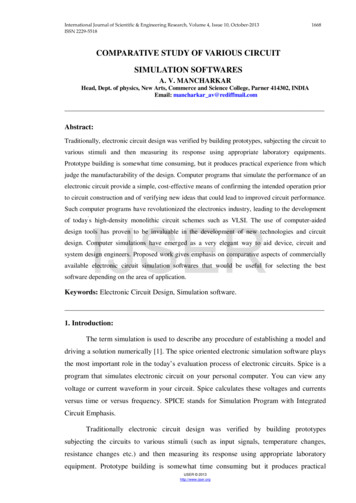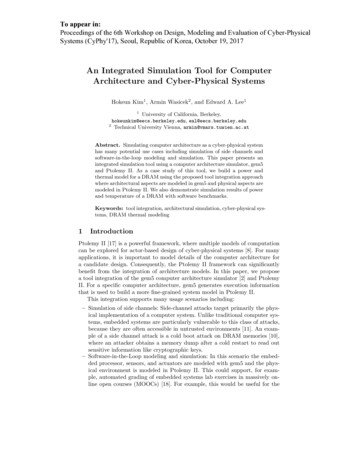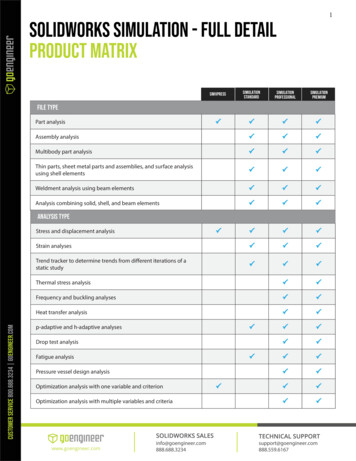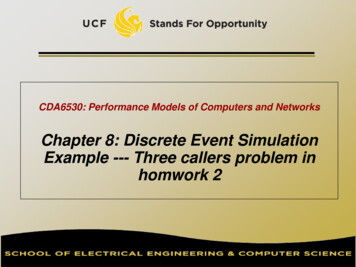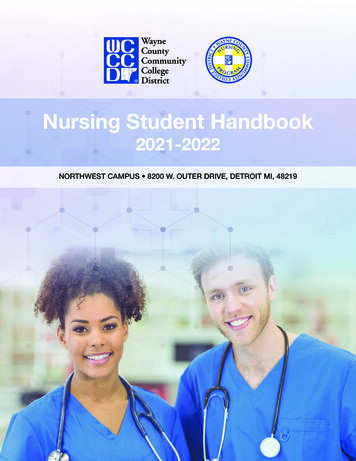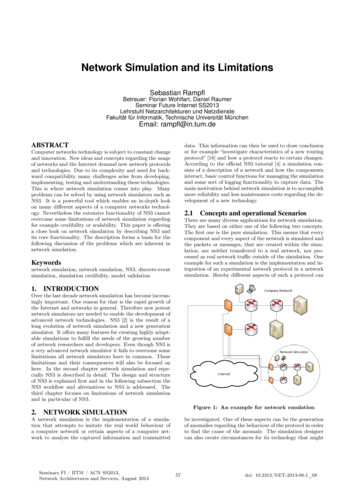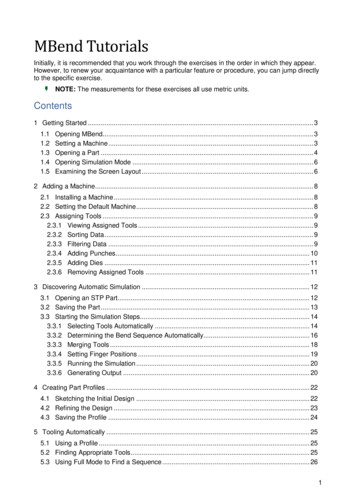
Transcription
Proceedings of the 2017 Winter Simulation ConferenceW. K. V. Chan, A. D'Ambrogio, G. Zacharewicz, N. Mustafee, G. Wainer, and E. Page, eds.HISTORY OF COMPUTER SIMULATION SOFTWARE: AN INITIAL PERSPECTIVERichard E. NanceC. Michael OverstreetVirginia TechBlacksburg, VA 24061 USAOld Dominion UniversityNorfolk, VA USAABSTRACTThe evolution of computer simulation software until the mid-1980’s is subsumed by descriptions of thehistory of simulation programming languages. Since that time, the entire complexion of simulation modeldesign, development, execution, and sustainment has undergone a radical transition. The transition to alarge degree stems from technology advances in hardware and software coupled with the increasingexpectations of simulation modelers and end users. This study, covering the evolution in its entirety,represents an initial perspective on the transition based on an examination and analysis of the WinterSimulation Conference Archive and a partial set of simulation software surveys published in OR/MSToday. The results characterize the modeling and simulation software evolution since the mid-1980’s interms of newcomers, endurers, fads, fades, trends, and trajectories. Prominent among the conclusions arethat commercial firms are driving the major advances and the marketplace is quite volatile.1THE BEGINNING AND BEYOND (1958-1980)1.1Prior Treatments of Computer Simulation HistoryHistorical descriptions of computer simulation (or, more specifically, discrete event, Monte Carlo,combined, and hybrid simulation) generally fall into one of three classes: an inclusive treatment of the technical field; e.g., Nance and Sargent (2002),a focus on a specific simulation programming language; e.g. Gordon (1981), ora focused treatment based on selected topics; e.g. Robinson and Taylor (2008), Hollocks (2008).The example from the last class listed above recognizes the contributions of Keith Douglas Tocher,who created the first simulation package, the General Simulation Program (GSP), in 1958 (Tocher andOwen 1960).An exception to this classification is the comprehensive history of discrete event simulationprogramming languages (Nance 1996). Coupling that work with the in-depth development histories ofGPSS (Gordon 1981) and SIMULA (Nygaard and Dahl 1981) that are covered to a lesser extent becauseof their earlier treatment, an informative picture of Simulation Programming Language (SPL) technology,circa 1984, is achieved. More recent discoveries of contemporary works add details to that picture(Markowitz 1979), (Holmevik 1994), and (Krogdahl 2005). However, the advancement of computingtechnology since 1984, both hardware and software, expands the domain of simulation modeldevelopment, execution, and use well beyond the SPL level.978-1-5386-3428-8/17/ 31.00 2017 IEEE243
Nance and Overstreet1.2Objectives of an Initial PerspectiveThe objective of this paper is to offer a view of the evolution from SPL to simulation software, or moreaccurately, Modeling and Simulation (M&S) software. The view proffered relies on an analyticalcomponent, coupled with a subjective approach. Two sources of data to characterize this evolution withquantitative and subjective examination are employed: The Winter Simulation Conference (WSC) Archive that includes proceedings, and in some yearsprogram and other material, from each annual conference (WSC Archive, http://informs-sim.org).The Archive is subject to Google search.Simulation software surveys conducted on roughly a two-year cycle by James J. Swain andpublished in OR/MS Today since 1991. Only a subset of the surveys, primarily the later issues, isaccessible he population of contributors to these two sources is not independent sets. However, the contributorsto each database, a broad cross-section of the computer simulation community in the first case and activeM&S software vendors in the second, are likely to possess quite different views of their relation to thefield.The objectives of this work in no way include providing a comparative evaluation of M&S softwareproducts, and interpretations, observations, speculations, and conclusions offered herein should not beconstrued as doing so.2THE EXPANDED SCOPE OF M&S SOFTWAREAs early as the mid-1960s, prominent SPL designers, simulation educators, and application specialistsrecognize that the divergences among the elements of the community are drawn along languageboundaries. Comparisons of languages are prominent in publications (Krasnow and Merikallio 1964,Teichrow and Lubin 1966, Kiviat 1966); and conferences and workshops focus on SPL characteristicsand applications (Hollingdale 1967, Buxton 1968). A more detailed description of the early importanceof conferences and workshops is provided in section 8.3.9 of Nance (1996).The demise of comparative SPL publication and conference activities stems from two coincidentfactors: (1) the transition of extant languages to, and the rapid appearance of new languages as,commercial products vying in a competitive marketplace; and (2) the emergence of the WSC as a nationaland international forum for communications in all aspects of simulation. The strength of the latter (WSC)influence cannot be overstated.Beginning in the late 1970’s, a succession of major hardware advances creates an almost illogicalsituation wherein the: physical size of basic logic and storage units is decreased by orders of magnitude;cost of these elements is reduced in a similar fashion;central processing unit, memory access, and disk access speeds of these elements are increasedaccordingly;graphics device costs are likewise reduced; andcomputer networking costs and performance render less expensive distributed systems.The manifestation of these advances in the 1980’s results in microprocessors with storage andcomputational capabilities exceeding those of mainframe computers only a decade earlier.Multiprocessor architectures are implemented as software technology responds to enable communicationsrealizing network computing, personal computer (PC) workstations, and new dimensions in computergraphics. The influence on computer simulation is affirmed by model development and simulation244
Nance and Overstreetsupport environments supplanting a SPL; parallel and distributed simulation significantly extending theapplication boundaries; and graphics-based interfaces replacing the limited output animations of the past.The revival of gaming as vitally linked to simulation, through both training and entertainmentapplications, promotes an ironic recollection for those who once were members of The Institute ofManagement Sciences (TIMS) College on Simulation and Gaming. “Human-in-the-Loop” models alsoexperience a revival. Virtual reality, “Big Data” analysis, and web-based simulation are fathered by thetechnology influences. The scope of M&S software evolution today dwarfs the SPL subject domainsketched in the preceding section.3CHARACTERIZING THE EVOLUTION OF M&S SOFTWAREAny description of the evolution of a technical field, the influence of a movement, or even the biographyof an individual, extending over 50 years, must include subjective judgments. Nevertheless, to the extentthat arguments, conjectures, speculations, or claims can be grounded in quantitative analysis, the morelikely the acceptance of the conclusions, especially in scientific fields. This rationale requiresidentification of a data source (or sources) that best reveals the features undergoing changes in M&Ssoftware over this extended period. Additionally, a procedure must be developed to identify the featuresand extract the nature of the changes. The basis for selecting the WSC Archive and the simulationsoftware surveys from OR/MS Today, and the procedures applied to each, are described in the followingsections.4THE WINTER SIMULATION CONFERENCE (WSC) ARCHIVEThe identification of a data source (or sources) that best reveals the M&S software evolution is not asimple matter. Beyond the obvious requirements that the source (or sources) be openly published andreadily accessible, what other characteristics might emerge to determine “best reveal”? Several datasource options deserve consideration, perhaps the most apparent among them being:1. All M&S software papers from a selected number of peer-reviewed journals during the period1967 to 2016.2. All M&S software papers from the proceedings of a selected number of conferences, publishedduring the period 1967 to 2016.3. A combination of the above two options.4. All M&S software articles from the WSC Proceedings for the period 1967 to 2016.One argument against Option 1 is that no peer-reviewed journals dedicated to discrete eventsimulation, or the combined and hybrid modeling extensions, exist before 1990 when the ACMTransactions on Modeling And Computer Simulation (TOMACS) is launched. Simulation areas ordepartments with managing editors exist in a number of professional peer-reviewed journals; but thecompetition with other areas or departments is intense. Thus, a very small sample with only partialcoverage of the target period is obtained. Additionally, this small sample is produced by the decisions of afew individuals from editorial boards (associate and area editors) that change very little from year to year.The effect of subject and treatment bias is likely. Option 2 would require the selected conferences todemonstrate a general approach to topics in M&S software rather than a specialized focus. Anotherproblem is the longevity issue; i.e., the life of a conference is problematic, and a sample composed ofdifferent conferences from year to year would strain the desired homogeneity expectation. Moretroubling with regard to Option 2 is the quality of papers composing the sample; since the motivation tobase acceptance decisions on the need for a sufficient number of conference registrations is widelyrecognized. Option 3 cannot be seriously considered given the shortcomings of both Options 1 and 2.Option 4 appears to suffer less from the objections raised for the other three (or the first two).Although the acceptance criteria appear to have been tightened over the years, the changes have been245
Nance and Overstreetgradual. While simulation software and “modelware” articles constitute but a subset of the M&Scoverage within each conference, that focus persists for every instance. Furthermore, the submissionpopulation from which the papers are accepted consists of practitioners, researchers, students, teachers,and users in the field. As such, the articles (research papers, panel descriptions and position statements,and M&S software tutorials) are more likely to reflect trends and trajectories in M&S software than wouldbe demonstrated by the papers from a peer-reviewed journal. Finally, the proceedings of the annual WSCare available online for the period 1968-2016 from the ACM Digital Library and from the INFORMSwebsite. The INFORMS source appears to be more complete since the ACM Digital Library omits somepresentations, particularly if only an abstract is available.4.1Examination of the WSC ProceedingsThe procedure relies on the fact that M&S software, as a publication area, is divided into topical subsets,or categories, defined a priori to cover a large proportion of articles spanning the subject area.Modifications to the categories based on the examination to follow are permitted (a category may beadded, deleted, merged with another, or retitled). For each year, a manual review of each available paperor abstract (article) is performed to identify those describing tools intended to support the creation of amodel (conceptual to executable representation) or model element intended for use in a M&S study. Atotal of 1303 articles are identified. Each article considered to fall within the M&S software subject areais assigned to one or more of the topical categories. Note that “Other” is always a topical category,drawing 26 assignments, a relatively low number compared with other categories. In addition, severalcategories draw too few articles to make meaningful analysis possible and are discarded. The result is thenumber of articles (a frequency count) for each category for each year. The intent is to identify patternsand shifting interests, occurring over time, that reflect emerging, persistent, and receding interests inM&S support tool capabilities. Considering the high number of articles assigned and the restricted timeallotted to each article, the examination cannot be considered in-depth; but the accuracy is believed to besufficient for allowing a quantitative perspective on M&S software evolution.4.1.1Scope of the WSC Archive DataThe WSC Archive provides online access to 48 years of Proceedings of the Winter SimulationConference, covering the period 1968 through 2016 that are amenable to Google search. The proceedingscontents include the full text of research papers; initially, only title then abstracts in some cases, fullpapers in others, for panel discussions; papers and abstracts from software vendors; and abstracts of Ph.D.student posters. Figure 1 below illustrates both the growth in total proceedings contents (items) over timeand in those items identified as describing M&S support software (“support sw ct”). Included in the itemcontent count are research papers, keynote addresses, abstracts from software vendors, Ph.D. abstracts,and panel discussions. A total of 10,671 items are included in the Proceedings count, of which 1303(12%) describe M&S support software. Somewhat surprising is that since 1996, while total itemsincrease significantly, M&S support software items decrease slightly.A plausible explanation for the relatively sharp increase in simulation support software items in the1986-87 timeframe is the emergence of model development or simulation support environment tools in adesign or prototype form. Two software tutorial tracks, one labeled, “General Purpose” with nine articlesand the other, “Special Software” with 15, are shown in the 1986 program. The 1985 program has a singletrack with nine articles. Moreover, a session devoted to model development and simulation supportenvironments appears for the first time in 1986, and the object-oriented paradigm is prominent inmodeling methodology sessions. The relatively level or slightly increasing trend over the next decademight be attributed to the increasing appearance of environment-related articles and the relativelyconstant number of SPL tutorial articles; the total reaches a peak in 1997 and trends downward as the SPL246
Nance and OverstreetFigure 1: Content count in total and simulation support software items by year.articles diminish. From 2003 to 2015, the relatively constant number of articles likely is reflective ofcommercial (vendor) dominance in this subject area. The identification of “Software/Modelware Track,”introduced in 1990, gains the parenthetical “Vendor” designation in 2006. The next year and thereafter,“Vendor Track” is the designation. The slight blip in 2011 is explained in a subsequent section.A repeated caution about the numbers. Given the large volume of data subject to examination, somecounts presented here might not be exact but should be sufficiently accurate for the intended purposes:recognizing behavioral patterns, comparing count statistics, and identifying trends.4.1.2Frequency Count for Article ContentThe examination identifies more than 1300 articles concerning tools to support the creation orsustainment of models used in M&S projects. Each article is assigned to a category; although a few areassigned to multiple categories when an article is judged to address each category. The assignment of anarticle to a particular category can involve varying levels of subjectivity; e.g., deciding whether an articledescribes a general-use SPL that can be employed to create models in many problem domains, a specialpurpose SPL with application to a single problem domain, or an individual SPL model with parametersthat allow some variation in the use of the model.Some “hot” topical areas in recent conferences are yet to produce an influence on M&S softwarediscernible in WSC articles. One such category is “agent-based modeling” that does appear, but notsufficiently frequent in its relation to M&S software. The increase in attention to the topical area of hybridsimulation is remarkable: six sessions in both WSC 2014 and 2015 and with a track consisting of ninesessions and an introductory tutorial in WSC 2016. Hybrid simulation at this point is decidedlyapplication-domain driven. A notable influence on M&S software is yet to materialize.Table 1 lists many of the frequently occurring topics. Recall that a single item may be counted inmultiple categories. As noted above, infrequently occurring topical categories are omitted. Selected247
Nance and Overstreettopical areas from Table 1 are also presented in graphs that follow to demonstrate how their frequencypatterns vary with time.Note that the highest category is “Language tutorials” (tutorials on SPLs). Most of these tutorialsaddress languages that are commercial products. The tutorial frequency is influenced by the yearlyrepeats by the developers (vendors) to create product exposure and to promote marketing opportunities.Likewise, many special purpose SPLs, supporting model development in a particular application domain,such as design of network architectures or applications in a manufacturing domain, are also commercialproducts and are presented over successive years. Consequently, the higher frequency for these two areasis due both to the marketing efforts of the developers (vendors) and the continued interest of conferenceattendees in their products. In recent years, the larger vendors offer workshops featuring in-depthdiscussion of their products. User group meetings hosted by vendors is a tradition at WSC, and thecombination of tutorials and the informal meetings enhance relationships with current clients and creatediscussions in a social atmosphere with potential users.Table 1: Article counts by content area.TopicLanguage tutorialsSimulation extensions to existinggeneral-purpose languagesSpecial purpose SPLSimulation implementationtechniquesSimulation graphicsStatistical support of simulationWriting simulations in non-SPLsVirtual reality and simulationSimulation developmentenvironmentsWeb-based simulationSimulation supportDistributed and parallelsimulationHigh Level Architecture 20115219615Observations emanating from the examination that are not revealed in Table 1: The technology transition, from research concept to commercial product, is exhibited in a fewareas; e.g., the concept “model development environment” is projected as a research goal in twopapers (Henriksen 1983, Nance 1983); then in 1990 with the evaluation of a prototype tool (Balciet. al. 1990); and subsequently in the realization of a commercial product, the Visual SimulationEnvironment (VSE) in 1995 (Balci et al. 1995).The encapsulating topical area, “simulation development environments” over time merges, atleast in part, with evolving older SPLs and newly-designed languages. The early SPL products,providing only a compiler and language documentation, give way to a suite of complementarytools marketed in total by a single vendor or configured by the user from M&S softwareauxiliaries and utilities provided by multiple vendors.Graphics tools (to graph output data or to provide output animations), distribution-fittingsoftware, and other utilities complement the SPL in an encompassing environment to expand andextend M&S capabilities.248
Nance and Overstreet 4.1.3The high number of High Level Architecture (HLA) articles reflects both the interesting set ofproblems requisite in creating efficient large, reusable, and interoperable distributed simulationsand the continued funding of the U.S. Department of Defense.Time Traces for Selected Topical AreasFigure 2 provides a set of graphs with data aggregated across multiyear intervals, typically ten years, tosmooth year-to-year variations and to show long-term trends.Figure 2: Topic frequency changes over time.The plotted data are the average number of papers presented in each conference on the ordinate (yaxis) during the time interval identified on the abscissa (x-axis). An immediate observation is the cleardifferences among the graphs. Moreover, three identifiable subsets appear: (1) topical areas where theaverage number of articles demonstrates a steep rise followed by a significant decline (Distributed andParallel Simulation, Support of Graphics, and Simulation Development Environments); (2) topical areas249
Nance and Overstreetshowing a steep rise followed by a leveling (Simulation Language Tutorials, Simulation Extensions toProgramming Languages); and (3) a topical area (Special Purpose Simulation Languages) with a moregradual rise persisting throughout nearly 50 years. Admittedly, the scales on the ordinate axes differ, andthe measures are relative to the total number of articles appearing in that topical area. Yet, the differencesstimulate more specific explanation. The topic, “Distributed and Parallel Simulation” emerges in 1978-83; thus a count of zero articlesin the first decade is self-explanatory. The steep climb during 1980-2000 shows the intenseresearch activity in the techniques for efficient execution, initially creating two camps, nominallylabeled “conservative” or “optimistic,” each advocating its position with religious fervor during1984-1994. A conference, launched in 1985 to address distributed simulation adopts the name,“6th Workshop on Parallel and Distributed Simulation (PADS 1992)” in January 1992. Researchactivity in the topical area intensifies as the decades transition; and, in the opinion of many, adefining event is the publication of a challenging feature paper by Fujimoto (1993), accompaniedby reactive commentaries from leading researchers in the area, and concluding with a rejoinder.The question of survivability of parallel simulation as a viable research area is viewed as a clarioncall by the commenters, with possibly one exception.The plot for “Support of Graphics” shows zero papers in the first decade due to lack of affordablehardware to support these features. As the cost for graphics hardware decreases, a rapid rise isevident during the 1980-89 period followed by a lesser rate in 1990-99. The decrease after 2000reflects the incorporation of graphic capabilities into simulation environments, largely eliminatinga need for separate graphics support.Articles in the category “Simulation Development Environments” show similar behavior. Theconcept is introduced in 1982-83, materializes in research articles during the period 1980-89,followed by prototypes with gradual insertion into commercial products during 1990-99. By2000 the SPL is supplanted by the suite of model development and simulation support tools.The rise and continuing level of articles in “Simulation Extensions to Programming Languages”stems from a recognized characteristic of human behavior: resistance to change or learningsomething new. While this interpretation might seem tinged with cynicism, the old claim that,“more simulation programs have been written in FORTRAN than any other language” still retainscredibility. The rise from 0.6 during 1968-79 to 1.2-1.6 over the following 36 years can beattributed to the increase in programming languages introduced during that period; e.g., Pascal,Ada, C and all the other extensions to C, Prolog, Modula-2, Java, Python, and the list goes on.The ascendant behavior from 1968 to 1999 in “Simulation Language Tutorials” in part reflectsthe effect of simulation extensions to general programming languages described above. Also afactor is the perception of unmet needs as software and hardware technology advances raiseexpectations that drive increasing modeling complexity. The transition from M&S softwarecapability provided by a SPL to simulation development environments as vendor products during1990-2000 accelerates the motivations for educational and marketing opportunities as WSCexpands and consolidate its image as the premiere international conference in the field.The rather distinctive behavior displayed in “Special Purpose Simulation Languages” is moredifficult to characterize. The meaning of the term “special-purpose” in the 1970’s is exemplifiedmost notably by SIMSCRIPT II as a base for languages, such as ECSS II and CSP II, supportingcomputer systems performance modeling. In the 1980’s, application-domain-dependent userinterfaces are created by the vendor (CACI) for performance modeling of general networks(NETWORK II.5) and communication networks (COMNET II.5). Adoption of terminologygermane to the problem domain coupled with a menu-driven graphical user interface is touted as“modeling without programming.” A related software tool for local area networks, LANNET II.5250
Nance and Overstreetfollows shortly (Garrison 1991). Additionally, languages simplified to support a single problemdomain may be learned more readily.4.1.4M&S Language and Environment AnalysisThe examination identifies 225 SPLs and environments as subjects of WSC articles, although this numbershould be treated with some caution since: distinguishing a new tool in a highly versatile SPL from the evolution to a new language can bedifficult,some model implementations are intensely data-driven and might be regarded as a new language,andas languages evolve, sometimes names are changed; e.g. the transition from SLAM as a SPL toSLAMSYSTEM.Table 2 lists the languages (or language-based environments) that have tutorials in at least threeconferences. Interestingly, of the 225 languages, 159 (71%) appear in a single conference. The table isordered by the year in which the first tutorial for the language appears, and a count of the number oftutorials for that language is given.Clearly, GPSS exhibits the highest longevity. The top five SPLs or environments in frequency oftutorials are GPSS (35), AutoMod (26), Arena (22), SIMSCRIPT (18), and ProModel (17). Furtherobservations are suggested by examining Table 2 or derived from the extensive review required for itsproduction. General programming languages continue to play a significant role as a base; some are used toconstruct (library) packages (Pascal PASSIM, C CSIM, Java JavaSim), others aslanguage extensions (Pascal SIMPAS), and yet others provide an implementation framework(Python SimPy).Traditional SPLs are tailored to produce domain-specific dialects (SIMSCRIPT II.5 NETWORK II.5 and COMNET II.5) or simulation support environments (SLAM VisualSLAM AweSim).Packages in newer programming languages are created from the early SPLs, in some cases fromthe underlying conceptual level. Of signal interest is javaSimulation where the basic constructs ofSIMULA, including the co-routine structure employing the thread capabilities of modernoperating systems, are implemented in simulation packages executable on PC, Mac, and Sunplatforms (Helsgaun 2000). An interesting alternative approach is described in L’Ecuyer, Meliani,and Vaucher (2002), which cites several other Java implementations for simulation.With 157 of the 225 “languages” appearing in a single conference, a large number of “flashes” or“one-year wonders” is evident, indicating that simulation software could be perceived as a richarea for language designers while proving to be a “magnetic sinkhole” for prospectiveentrepreneurs.The rise and subsequent decrease of interest in areas of simulation software, such as graphics andparallel and distributed simulation, is confirmed by the figures reflecting the maturation (or“fades”) in these areas.251
Nance and OverstreetTable 2: Tutorials for computer simulation programming languages or environments.Software SNETWORK II.5ExcelCINEMASmalltalkSIMPLE 1SEE WHY, WITNESSSIMFACTORYCSIMSIMNETFACTORRESQMECOMNET II.5SIM IMMicro SaintLayOPTSIMPRESS IIIAweSimFlexsimAnylogicSimul8ExtendSim 7Emulate3D FrameworkSimioSAS Simulation 520162016Numberof 5539335141149697
Nance and Overstreet4.2Questions and SpeculationThe persistent interest in using newer general programming languages and their extensions for simulationis intriguing. Is the explanation provided above for the “Sim. Extension to Prog. Lang.” graph sufficient;i.e., reluctance of users facing the challenge of a M&S task to learn a new language? Historically, thisexplanation undoubtedly applies in the NGPSS case where the compiler is written in COBOL (Nance1996), but does that alone explain why articles in this category continue to appear at about the samefrequency? Does it apply to GASP PL/I in which a statement-by-statement syntactic translation fromFORTRAN into PL/I, utilizing none of the PL/I features, is apparent? Is the motivation driving thetransitory interest in Ada for simulation in the mid-1980’s the same as that for the more specializedlanguage Prolog? From a wider historical perspective, alternative explanations might include: (1)broadening the potential user (client) community, or (2) utilizing features and capabilities in advancingsoftware technology. Might another explanation be the desire by some to “show off the newest tool”?5OR/MS TODAY: SIMUL
The basis for selecting the WSC Archive and the simulation software surveys from OR/MS Today, and the procedures applied to each, are described in the following sections. 4 THE WINTER SIMULATION CONFERENCE (WSC) ARCHIVE The identification of a data source (or sources) that best reveals the M&S software evolution is not a simple matter.

